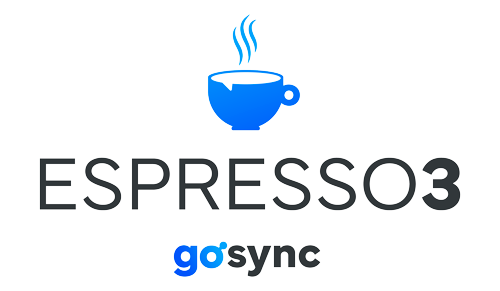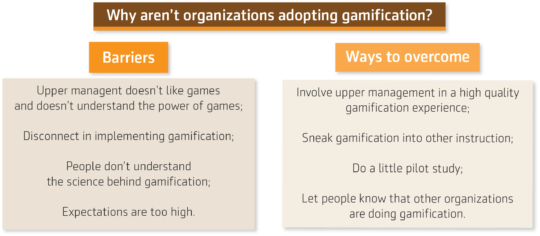Hi, I’m here with Karl Kapp and we will talk about why organizations are not adopting gamification. I’m Wagner Cassimiro and this is the Espresso3.
Karl, what are the main barriers that organizations face to implement gamification?
Yes, I think there are a number of barriers that organizations have. One, which I find very interesting, is sometimes the upper level of the organization thinks games are really a bad thing. They don’t like games. And they don’t understand the power of games and what games are able to add to the organization. So that’s a problem sometimes.
Another problem that I’ve seen sometimes is the upper level management of the organization really likes games and gamification. “It’s ok, we’re going to implement this!” And then they don’t talk to the people that are actually are going to be playing the game or doing the gamification and there’s a disconnect. So the people in charge go “oh we can’t have cartoon characters because that’s a bad thing” meanwhile the people that actually have to take it every day are like “Yeah, cartoon characters will be great! I would love to do that!” So I think sometimes there is this disconnect in implementing gamification.
I think another thing is people don’t understand. They really think that gamification is just about playing and having a good time… and not really learning. They don’t understand the science behind gamification and why gamification elements actually drive learning and aid retention. So there is some educational perspective that has to be done in order for that to happen.
And I think the final thing, I find this is somewhat interesting, if you have really hard core gamers in the organization, they’ll want everything to look like “Halo 3”, or “Call Of Duty” and then their expectations are too high. We need to come back down to earth and say “look, gamification in a corporate environment is not going to be a PlayStation 4 type of game or a triple “A” title, but it’s going to be more interactive, more engaging and more impactful than your typical traditional instructions”.
So I think those are some barriers that…. They all can be overcome but we certainly will have to work toward that.
And what should I do to overcome these barriers?
Ok. So there’s a couple of things that can be done. One is actually involve upper management in a high quality gamification experience. I’ve had a lot of experiences where we take people that are like “yeah, I don’t like gamification” and we actually said “ok, this is not gamification. It’s a simulated activity”. Even though it was gamification. And they did it and were like “wow, boy this makes the difference!” and we say “well yeah… that’s what we are talking about! That’s what we want to do in the organizations”. So, give them that experience I think is one.
The other way is to kind of sneak it into other instruction that they are doing in the organization. So rather than ask for permission, you beg for forgiveness after someone says “what are you doing?!”. But most of the time people that are going through that experience find it very engaging and very interesting.
And the other thing is…. I guess it’s similar, but do a little pilot study. So take a small group, with very low-hanging fruit, something that you know you can be successful on, and go ahead and drive that. Well, we say a lot of times “what is your real big pain points in your organization that you don’t seem able to solve?” and “let’s just try a little pilot with gamification and see if that helps”.
So oftentimes, because it’s a very chronic problem, because no other solution has worked, and because gamification is a little different, that combination usually provides a good result, and that kind of overcome that barrier, that resistance.
And finally I say “let people know that other organizations are doing gamification”. If you have organizations at the Summit, you know, we had this great gamification summit, and we saw organizations like SAP, IBM, at the Espresso3 Summit… Bradesco… we are using gamification and here is how we’re using it. And to me, you know, if they’re using gamification to get to their employees, why shouldn’t every organization be doing that. So I think that can help people overcome their barriers. They will find out “hey, if this was childish, IBM, SAP and Bradesco would not be doing it!”. That I think is a big forward thinking movement that you can get people to overcome some of their resistance.
TRADUÇÃO
Olá, estou aqui com Karl Kapp e vamos conversar sobre por que as organizações não estão adotando gamificação. Eu sou Wagner Cassimiro e este é o Espresso3.
Karl, quais são as maiores barreiras que organizações enfrentam para implementar a gamificação?
Sim. Eu acho que existem várias barreiras que organizações possuem. Uma, que eu acho muito interessante, é que às vezes os níveis mais altos da organização pensam que jogos são uma coisa ruim. Eles não gostam de jogos. E eles não entendem o poder dos jogos e o que os jogos podem adicionar para a organização. Então isto é um problema algumas vezes.
Outro problema que eu já vi algumas vezes é que a alta gestão da organização gosta muito de jogos e gamificação. “Está ok, vamos implementar isto!” e então eles não falam com as pessoas que realmente irão jogar o jogo ou participar da gamificação e isto cria uma desconexão. Então, as pessoas responsáveis dizem “Não podemos ter personagens porque é uma coisa ruim” enquanto as pessoas que vão fazer isto diariamente dizem “Sim! Personagens são ótimos! Eu adoraria isto!” Então eu penso que algumas vezes há esta desconexão na implementação da gamificação.
Eu creio que outra coisa é que as pessoas não entendem. Eles realmente acham que gamificação é apenas jogar e se divertir e não aprender de verdade. Eles não entendem a ciência por trás da gamificação e por que os elementos de gamificação realmente impulsionam o aprendizado e auxiliam na retenção. Então há uma perspectiva educacional que precisa ser feita para isto acontecer.
E eu acho que a última coisa, que eu acho um pouco interessante, se você tem jogadores adeptos na organização, eles vão querer que tudo se pareça com “Halo 3”, ou “Call Of Duty” e então as suas expectativas serão muito altas. Precisamos colocar os pés no chão e dizer “olha, gamificação em um ambiente corporativo não será um jogo no estilo do PlayStation4 ou um título de sucesso, mas será mais interativa, mais engajadora e mais impactante do que as suas experiências tradicionais de instrução”.
Então eu penso que estas são algumas barreiras que… Todas podem ser superadas, mas certamente temos que trabalhar nesta direção.
E o que eu preciso fazer para superar estas barreiras?
Ok. Existem algumas coisas que podem ser feitas. Uma é envolver a alta gestão em uma experiência gamificada de alta qualidade. Já tive diversas experiências onde pessoas estão “é, eu não gosto de gamificação” e nós dissemos “ok, isto não é gamificação. É uma atividade simulada”. Apesar de ser gamificação. E eles diziam “uau, isto realmente faz diferença!” E dizemos “bom, sim… é disto que estamos falando! É isto que queremos fazer nas organizações”. Então dar a eles esta experiência eu penso que é uma coisa.
A outra maneira é inserir discretamente em outros treinamentos que estão fazendo na organização. Então, ao invés de pedir permissão, você pede perdão após alguém dizer “O que você está fazendo?!”. Mas a maioria das vezes as pessoas que estão passando pela experiência acham muito engajadora e interessante.
A outra coisa é… Eu acho que é parecido, mas fazer um pequeno estudo piloto. Pega um grupo pequeno, com atividades simples e fáceis, algo que você sabe que pode fazer com sucesso e ir em frente e realizar isto. Bom, dizemos muitas vezes “quais são suas maiores dores na organização que parecem não conseguir resolver?” e “vamos tentar um pequeno piloto com gamificação e ver se ajuda”.
Então, frequentemente, como é um problema crônico, como nenhuma outra solução funcionou e porque gamificação é um pouco diferente, esta combinação traz um bom resultado, e isto supera aquela barreira, aquela resistência.
E finalmente eu digo “deixe as pessoas saberem que outras organizações estão fazendo gamificação”. Você tem organizações no Summit, você sabe. Tivemos um grande Summit de gamificação e vimos organizações como SAP, IBM, no Espresso3 Summit… Bradesco… “Nós estamos usando gamificação e é assim que estamos usando”. E para mim, você sabe, se eles estão usando a gamificação para atingir seus funcionários, por que todas as outras organizações não deveriam estar usando? Então eu creio que isto pode ajudar as pessoas a superar suas barreiras. Eles irão perceber “ei, se isto fosse infantil, IBM, SAP e Bradesco não estariam fazendo!” Isto eu acho que é um movimento de pensamento bem evoluído que pode ajudar as pessoas a superarem um pouco de suas resistências.
Ok, muito obrigado!


